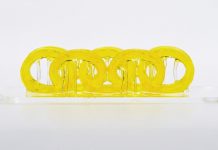
In a lab at the University of Glasgow, a team of scientists has made a groundbreaking leap by merging the worlds of chemistry and computers.
They’ve created a new kind of system that combines chemical reactions with digital technology to solve complex problems, making computers smarter and more efficient.
At the heart of their invention is a special chemical reaction known as the Belousov-Zhabotinsky (BZ) reaction.
This reaction is unique because it can keep changing between two states, much like a blinking light.
Imagine a sea of tiny lamps, some glowing while others are dim, each one flickering on its own but also influencing its neighbors. This is similar to what happens in the BZ reaction, and it’s this property that the researchers have harnessed to perform calculations.
Professor Leroy Cronin, the leader of the research team, was inspired by nature’s own computer: the brain. Our brains process information in a wet, messy environment, unlike the clean, digital environment of traditional computers.
Professor Cronin wondered if they could create a computer that works more like our brains, using chemical reactions to process information.
The Challenge with Traditional Computers
Today’s computers are incredibly powerful, but they’re hitting a wall. They rely on tiny components called transistors to function. As we try to make computers faster and more powerful, we shrink these transistors to pack more of them into the same space.
However, making transistors too small leads to problems: they become harder to make, use more energy, and produce more heat. This has pushed scientists to look for new ways to build computers.
Some have turned to quantum computing, a promising but difficult technology to scale up. Others, like Professor Cronin’s team, are exploring physical processes, like chemical reactions, as a new frontier in computing.
The BZ Reaction: Nature’s Blinking Lights
The BZ reaction is a fascinating chemical dance, where the ingredients periodically change color. This reaction doesn’t just occur in labs; it’s a part of many natural processes.
By understanding how these chemical changes can represent data (with one state representing a ‘0’ and the other a ‘1’), scientists can use the BZ reaction to perform calculations.
In the Glasgow lab, they built a three-dimensional grid where each cell contains the BZ reaction. This grid can be controlled electronically to start or stop the reaction, much like programming a computer.
By carefully controlling which cells are “on” (reacting) and which are “off” (not reacting), they can simulate the basic operations of a computer.
How It Works
The system uses cameras to watch the colors change in the grid of cells, turning the visual patterns into data that can be analyzed. With the help of advanced algorithms, the system interprets these patterns to solve problems.
One of the coolest things about this chemical computer is its ability to mimic some behaviors of living organisms, like growth and competition.
This isn’t just for show; it’s a way of solving complex problems through a process that resembles natural selection.
For example, the team showed that their system could tackle the traveling salesman problem, a classic puzzle that’s all about finding the shortest possible route through several cities.
This kind of problem is tough for traditional computers but turns out to be a good match for the Glasgow team’s chemical-digital hybrid.
Looking Ahead
The potential applications of this technology are vast. It could help make artificial intelligence systems more efficient, especially for tasks that involve understanding patterns or learning from data in nonlinear ways.
Professor Cronin is optimistic about the future. He envisions a time when this kind of chemical computing could be miniaturized and expanded, offering a powerful new tool for solving some of the world’s most complex problems.
The journey from here to there will be challenging, but the possibilities are as vast and varied as nature itself.
The research findings can be found in Nature Communications.
Copyright © 2024 Knowridge Science Report. All rights reserved.



